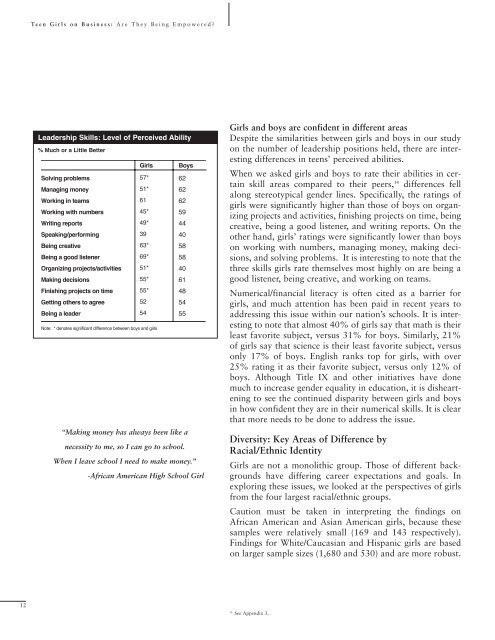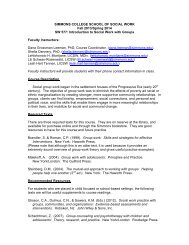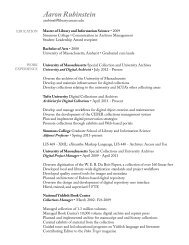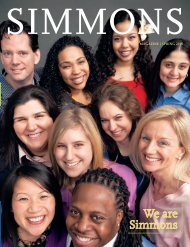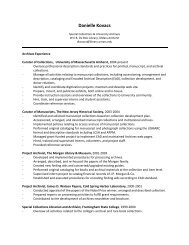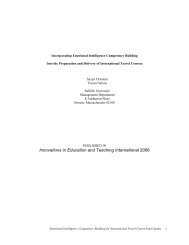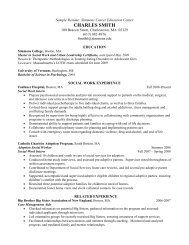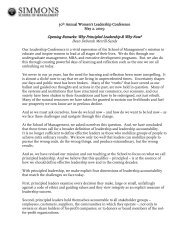Teen Girls on Business - Simmons College
Teen Girls on Business - Simmons College
Teen Girls on Business - Simmons College
You also want an ePaper? Increase the reach of your titles
YUMPU automatically turns print PDFs into web optimized ePapers that Google loves.
<str<strong>on</strong>g>Teen</str<strong>on</strong>g> <str<strong>on</strong>g>Girls</str<strong>on</strong>g> <strong>on</strong> <strong>Business</strong>: Are They Being Empowered?Leadership Skills: Level of Perceived Ability% Much or a Little Better<str<strong>on</strong>g>Girls</str<strong>on</strong>g> BoysSolving problemsManaging m<strong>on</strong>eyWorking in teamsWorking with numbersWriting reportsSpeaking/performingBeing creativeBeing a good listenerOrganizing projects/activitiesMaking decisi<strong>on</strong>sFinishing projects <strong>on</strong> timeGetting others to agreeBeing a leader57*51*6145*49*3963*69*51*55*55*525462626259444058584061485455Note: * denotes significant difference between boys and girls“Making m<strong>on</strong>ey has always been like anecessity to me, so I can go to school.When I leave school I need to make m<strong>on</strong>ey.”-African American High School Girl<str<strong>on</strong>g>Girls</str<strong>on</strong>g> and boys are c<strong>on</strong>fident in different areasDespite the similarities between girls and boys in our study<strong>on</strong> the number of leadership positi<strong>on</strong>s held, there are interestingdifferences in teens’ perceived abilities.When we asked girls and boys to rate their abilities in certainskill areas compared to their peers, 14 differences fellal<strong>on</strong>g stereotypical gender lines. Specifically, the ratings ofgirls were significantly higher than those of boys <strong>on</strong> organizingprojects and activities, finishing projects <strong>on</strong> time, beingcreative, being a good listener, and writing reports. On theother hand, girls’ ratings were significantly lower than boys<strong>on</strong> working with numbers, managing m<strong>on</strong>ey, making decisi<strong>on</strong>s,and solving problems. It is interesting to note that thethree skills girls rate themselves most highly <strong>on</strong> are being agood listener, being creative, and working <strong>on</strong> teams.Numerical/financial literacy is often cited as a barrier forgirls, and much attenti<strong>on</strong> has been paid in recent years toaddressing this issue within our nati<strong>on</strong>’s schools. It is interestingto note that almost 40% of girls say that math is theirleast favorite subject, versus 31% for boys. Similarly, 21%of girls say that science is their least favorite subject, versus<strong>on</strong>ly 17% of boys. English ranks top for girls, with over25% rating it as their favorite subject, versus <strong>on</strong>ly 12% ofboys. Although Title IX and other initiatives have d<strong>on</strong>emuch to increase gender equality in educati<strong>on</strong>, it is dishearteningto see the c<strong>on</strong>tinued disparity between girls and boysin how c<strong>on</strong>fident they are in their numerical skills. It is clearthat more needs to be d<strong>on</strong>e to address the issue.Diversity: Key Areas of Difference byRacial/Ethnic Identity<str<strong>on</strong>g>Girls</str<strong>on</strong>g> are not a m<strong>on</strong>olithic group. Those of different backgroundshave differing career expectati<strong>on</strong>s and goals. Inexploring these issues, we looked at the perspectives of girlsfrom the four largest racial/ethnic groups.Cauti<strong>on</strong> must be taken in interpreting the findings <strong>on</strong>African American and Asian American girls, because thesesamples were relatively small (169 and 143 respectively).Findings for White/Caucasian and Hispanic girls are based<strong>on</strong> larger sample sizes (1,680 and 530) and are more robust.1214See Appendix 3.


